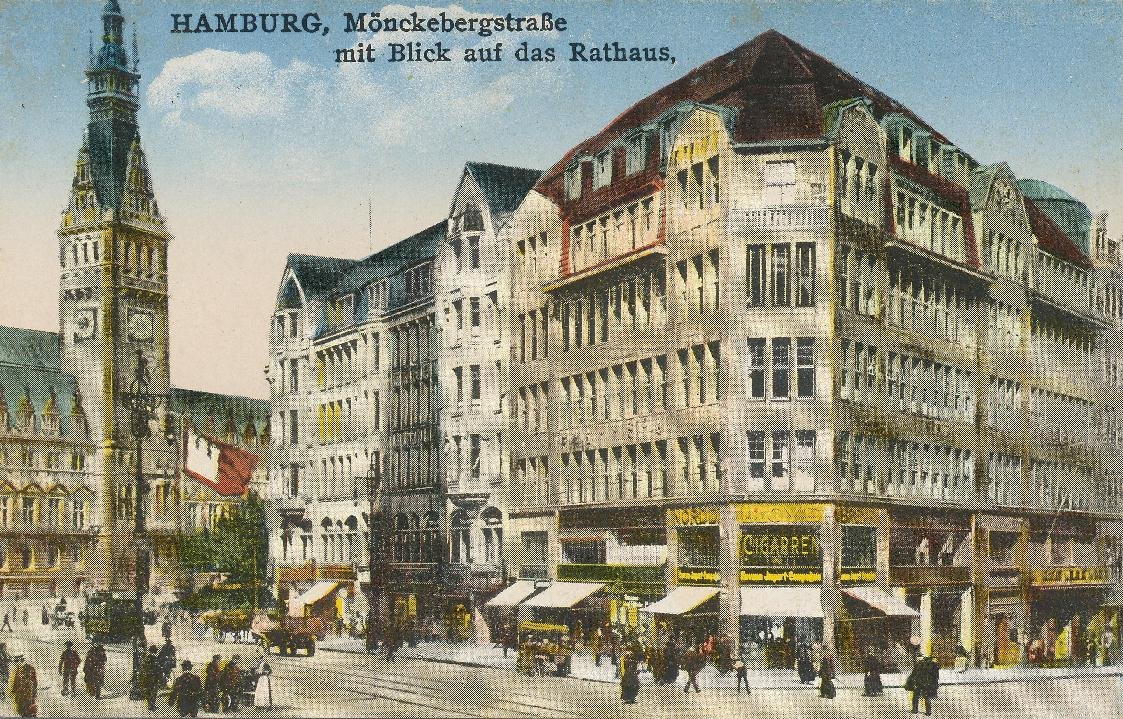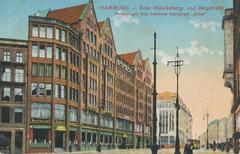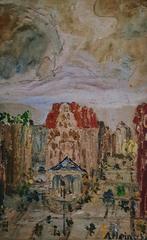
Mönckebergstraße Hamburg: Visiting Hours, Tickets, and Historical Sites Guide
Date: 15/06/2025
Introduction
Mönckebergstraße, fondly known as “Mö” by locals, is one of Hamburg’s most celebrated and dynamic shopping boulevards, seamlessly blending the city’s rich history, architectural splendor, and modern urban lifestyle. Established in the early 20th century and named after Mayor Johann Georg Mönckeberg, this bustling street connects Hamburg Hauptbahnhof (Central Station) with the grand Rathaus (City Hall). Renowned for its striking Hamburg Brick Expressionism, Mönckebergstraße serves as both a commercial powerhouse and a vibrant cultural artery, making it a must-visit destination for tourists and locals alike.
This detailed guide presents essential information on visiting hours, ticketing (notably, free access to the street itself), accessibility, guided tours, travel tips, and nearby attractions like St. Petri Church and the Speicherstadt warehouse district. Whether you’re a history buff, a passionate shopper, or a cultural explorer, Mönckebergstraße offers an engaging tapestry of Hamburg’s heritage and contemporary life. For in-depth planning and immersive exploration, visitors are encouraged to consult virtual tours and photographic resources on official tourism platforms. (hamburg.de, gpsmycity.com, hamburg.com)
Contents
- Historical Overview
- Origins and Early Development
- Architectural Significance
- Urban and Economic History
- Urban Renewal and Modernization
- Cultural and Social Impact
- Practical Information
- Visiting Hours & Tickets
- Guided Tours
- Travel Tips
- Accessibility
- Nearby Attractions
- Shopping and Gastronomy
- Special Events and Photographic Spots
- Frequently Asked Questions (FAQ)
- Key Facts and Statistics
- Conclusion and Call to Action
Historical Overview
Origins and Early Development
Mönckebergstraße’s roots trace back to Hamburg’s urban renewal following the Great Fire of 1842 and the devastating cholera epidemic of 1892. Realized between 1906 and 1909, the street was named after Mayor Johann Georg Mönckeberg, who championed the city’s modernization. Its construction cut a grand, direct axis from the Hauptbahnhof to the Rathaus, replacing the dense and unsanitary Gängeviertel. (hamburg.de, Wikipedia)
Architectural Significance
Mönckebergstraße is a showcase of Hamburg Brick Expressionism, with iconic red-brick facades and sculptural elements. Prominent buildings include the Levantehaus, Barkhof, and Klöpperhaus, which exude early 20th-century grandeur. The boulevard’s uniform building heights and tree-lined sidewalks create an inviting urban landscape. (gpsmycity.com)
Urban and Economic History
From its beginning, Mönckebergstraße was designed as a major commercial thoroughfare, featuring department stores, banks, and specialty retailers. Despite severe WWII damage, post-war rebuilding preserved its economic vitality, blending restored historic structures with pragmatic post-war architecture. Recent business improvement initiatives have modernized the street while honoring its historic roots. (Wikipedia)
Urban Renewal and Modernization
Recent years have seen significant investment in Mönckebergstraße’s infrastructure, including new energy-efficient lighting, improved seating, and enhanced seasonal decorations. Notably, the BID (Business Improvement District) program funded over €10 million in upgrades between 2017 and 2022, ensuring the boulevard remains attractive and functional for millions of annual visitors. (hamburg.de)
Cultural and Social Impact
Mönckebergstraße is more than just a shopping destination—it is a civic and cultural space. The boulevard hosts public events, parades, and demonstrations. Its proximity to key landmarks like St. Petri Church and the Rathaus reinforces its role as the heart of Hamburg’s Hanseatic identity and community life. Recent projects like the creative “Jupiter” hub highlight the street’s commitment to sustainability and urban innovation. (entwicklungsstadt.de)
Practical Information
Visiting Hours & Tickets
- Street Access: Mönckebergstraße is a public thoroughfare, open 24/7, with no entrance fee.
- Shops: Most stores open Monday–Saturday, 10:00 AM–8:00 PM; closed Sundays except for special events or legislative exceptions.
- Attractions: Some attractions (e.g., exhibitions within department stores or Levantehaus) may have individual opening hours and ticket requirements—check ahead for specifics.
Guided Tours
A variety of guided walking tours cover Mönckebergstraße’s history, architecture, and shopping highlights. Tours often include nearby sites such as the Rathaus and Levantehaus. Advance booking is recommended, especially during holidays or peak tourist seasons.
Travel Tips
- Best Time to Visit: Late spring to early autumn for mild weather and seasonal events. Weekday mornings and late afternoons are less crowded.
- Photography: The Levantehaus and illuminated facades offer excellent photo opportunities, especially after sunset.
- Events: Major events include Christmas markets, city parades, and cultural festivals.
Accessibility
- Pedestrian-Friendly: Wide sidewalks and minimal vehicle traffic make the street accessible for all, including wheelchairs and strollers.
- Transport: Served by U-Bahn (U3 at Mönckebergstraße), S-Bahn, and buses from Hauptbahnhof and Rathaus stations.
- Facilities: Public restrooms and seating areas are available throughout the district.
Nearby Attractions
- St. Petri Church: Hamburg’s oldest parish church, with regular tours and events.
- Rathaus (City Hall): Magnificent neo-Renaissance building offering guided tours.
- Speicherstadt: UNESCO-listed warehouse district, easily reachable on foot.
- Jungfernstieg: Popular promenade along the Inner Alster Lake.
Shopping and Gastronomy
Retail Landscape
Mönckebergstraße boasts over 300 shops in its area, offering something for every taste and budget. Major department stores like Karstadt and Galeria Kaufhof anchor the street, complemented by electronics giants Saturn and MediaMarkt Tech Village, as well as the Europa Passage shopping mall. Boutique arcades such as Levantehaus and Perle Hamburg offer unique shopping experiences. (hamburg-travel.com)
Fashion and Specialty Stores
International brands (H&M, Zara, Mango, & Other Stories) mix with Hanseatic boutiques (AppelrathCüpper, Thomas-i-Punkt), menswear specialists (Anson’s), and shoe and accessory retailers (Görtz, Douglas). Specialty shops include Wiesenhavern (electronics) and Gold Kraemer (jewelry).
Food and Drink
Cafés, bakeries, and restaurants line the street, offering local favorites like currywurst at Mö Grill and upscale cuisine at Tschebull. Outdoor seating is common in warmer months, and food stalls provide quick, tasty options for shoppers on the go. (hamburg.com)
Special Events and Photographic Spots
Events
Mönckebergstraße is a focal point for Hamburg’s seasonal festivities. During Christmas, the boulevard transforms into a festive market with lights, stalls, and performances. Other events include parades, cultural celebrations, and pop-up exhibitions, especially at creative spaces like Jupiter.
Photographic Highlights
Popular photo spots include the Levantehaus arcade, the street’s historic facades, and the striking backdrop of the Rathaus. Virtual tours and photo galleries are available on official tourism sites for planning and inspiration.
Frequently Asked Questions (FAQ)
Q: Is there an entrance fee to visit Mönckebergstraße?
A: No, the street is free and open to the public at all times.
Q: What are typical shop opening hours?
A: Shops are generally open Monday–Saturday, 10:00 AM–8:00 PM.
Q: Is the street accessible for wheelchairs and strollers?
A: Yes, the wide sidewalks and flat terrain make it highly accessible.
Q: Are guided tours available?
A: Yes, multiple tour operators offer walks featuring Mönckebergstraße’s history and architecture.
Q: Where can I park?
A: Nearby parking garages include Gertrudentor, Saturn, and Karstadt.
Q: Can I use credit cards at shops?
A: Most stores accept major credit cards; carrying some cash is advisable for small purchases.
Q: Is tax-free shopping available?
A: Yes, many stores offer tax-free shopping for non-EU residents—ask in-store for details.
Key Facts and Statistics
- Construction period: 1906–1909
- Length: Approximately 800 meters
- Named after: Johann Georg Mönckeberg, former mayor
- Architectural style: Hamburg Brick Expressionism
- Annual visitors: Millions, with up to 12,500 pedestrians per hour during peak periods
- Recent BID investment: Over €10 million (2017–2022)
(Wikipedia)
St. Petri Church: A Nearby Historical Highlight
St. Petri Church, Hamburg’s oldest main parish church, stands as a prime example of North German Brick Gothic. First mentioned in the 11th century, its iconic 132-meter tower shapes Hamburg’s skyline and offers visitors a unique perspective on the city’s spiritual and architectural heritage.
- Opening hours: Daily, 10:00 AM–6:00 PM (hours may vary on holidays and for services)
- Admission: Free; donations appreciated. Guided tours are available for groups with prior registration.
- Accessibility: The church is barrier-free, with ramps and elevators. Multilingual information is provided.
- Location: Centrally located near Mönckebergstraße, accessible by public transport, with parking nearby.
- Highlights: Regular concerts, exhibitions, and family-friendly events are held throughout the year.
Conclusion and Call to Action
Mönckebergstraße is the beating heart of Hamburg’s urban culture, offering a harmonious blend of history, shopping, gastronomy, and community life. Its continual revitalization—including environmental upgrades and creative projects like Jupiter—reflects Hamburg’s commitment to sustainability and innovation. With free public access, excellent transport links, and a wealth of attractions nearby, it remains a quintessential destination for both first-time visitors and seasoned Hamburg enthusiasts.
For the most enriching experience, download the Audiala app for guided audio tours, check out related posts on Hamburg’s top historical sites, and follow us on social media for the latest updates on events and insider tips. Plan your visit today and immerse yourself in the vibrant atmosphere of Mönckebergstraße—Hamburg’s historic and contemporary urban jewel.





















































































